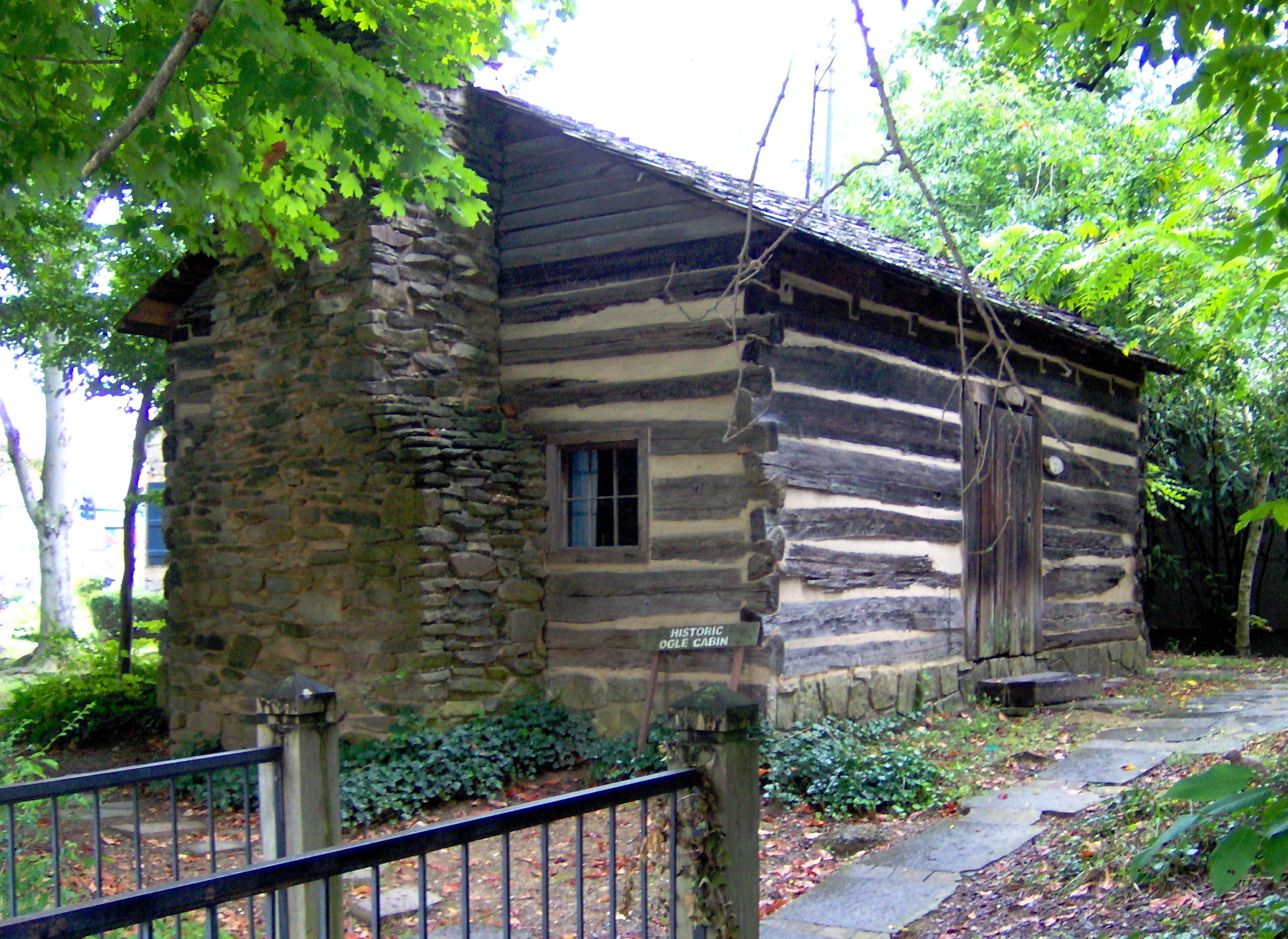|
Trillium Luteum
''Trillium luteum'', the yellow trillium or yellow wakerobin, is a species of flowering plant in the bunchflower family Melanthiaceae. It is a member of the ''Trillium cuneatum'' complex, a closely related group of sessile-flowered trilliums. The species is endemic to the southeastern United States, especially in and around the Great Smoky Mountains of eastern Tennessee and western North Carolina. Description ''Trillium luteum'' is a perennial, herbaceous, flowering plant that persists by means of an underground rhizome. Like all trilliums, it has a whorl of three bracts (leaves) and a single trimerous flower with three sepals, three petals, two whorls of three stamens each, and three carpels (fused into a single ovary with three stigmas). It has a sessile flower (no flower stalk), erect petals, and mottled leaves. It grows to tall by wide, with lemon yellow scented blooms. The large stalkless triple leaves often have grey-green marbling on the surface. It flowers in A ... [...More Info...] [...Related Items...] OR: [Wikipedia] [Google] [Baidu] |
Gotthilf Heinrich Ernst Muhlenberg
Gotthilf Heinrich Ernst Muhlenberg (17 November 1753 – 23 May 1815) was an American clergyman and botanist. Biography The son of Heinrich Melchior Muhlenberg, he was born in Trappe, Pennsylvania. He was educated at Franckesche Stiftungen in Halle starting in 1763 and in 1769 at the University of Halle. He returned to Pennsylvania in September 1770 and was ordained as a Lutheran minister. He served first in Pennsylvania and then as a pastor in New Jersey. He received a Doctor of Divinity degree from Princeton University. He married Mary Catherine Hall in 1774, with whom he would go on to have eight children. Despite his family beginning to take root in Philadelphia, Muhlenberg found he had no choice but to flee Philadelphia upon the outbreak of Revolutionary War hostilities in the region. Returning to his hometown of Trappe, he took up the study of botany. He served as the pastor of Holy Trinity Church in Lancaster, Pennsylvania from 1780 through 1815. In 1785, he was ele ... [...More Info...] [...Related Items...] OR: [Wikipedia] [Google] [Baidu] |
Sepal
A sepal () is a part of the flower of angiosperms (flowering plants). Usually green, sepals typically function as protection for the flower in bud, and often as support for the petals when in bloom., p. 106 The term ''sepalum'' was coined by Noël Martin Joseph de Necker in 1790, and derived . Collectively the sepals are called the calyx (plural calyces), the outermost whorl of parts that form a flower. The word ''calyx'' was adopted from the Latin ,Jackson, Benjamin, Daydon; A Glossary of Botanic Terms with their Derivation and Accent; Published by Gerald Duckworth & Co. London, 4th ed 1928 not to be confused with 'cup, goblet'. ''Calyx'' is derived from Greek 'bud, calyx, husk, wrapping' ( Sanskrit 'bud'), while is derived from Greek 'cup, goblet', and the words have been used interchangeably in botanical Latin. After flowering, most plants have no more use for the calyx which withers or becomes vestigial. Some plants retain a thorny calyx, either dried or liv ... [...More Info...] [...Related Items...] OR: [Wikipedia] [Google] [Baidu] |
Little Tennessee River
The Little Tennessee River is a tributary of the Tennessee River that flows through the Blue Ridge Mountains from Georgia, into North Carolina, and then into Tennessee, in the southeastern United States. It drains portions of three national forests— Chattahoochee, Nantahala, and Cherokee— and provides the southwestern boundary of the Great Smoky Mountains National Park. Numerous dams were erected on the river in the 20th century for flood control and hydropower generation. The river flows through five major impoundments: Fontana Dam, Cheoah Dam, Calderwood Dam, Chilhowee Dam, and Tellico Dam, and one smaller impoundment, Porters Bend Dam. Course The Little Tennessee River rises in the Blue Ridge Mountains, in the Chattahoochee National Forest in northeast Georgia's Rabun County. After flowing north through the mountains past Dillard into southwestern North Carolina, it is joined by the Cullasaja River at Franklin. The river turns northwest, flowing thro ... [...More Info...] [...Related Items...] OR: [Wikipedia] [Google] [Baidu] |
Casey County, Kentucky
Casey County is a county located in the U.S. Commonwealth of Kentucky. Its county seat is Liberty. The county was formed in 1806 from the western part of Lincoln County and named for Colonel William Casey, a pioneer settler who moved his family to Kentucky in 1779. It is the only Kentucky county entirely in the Knobs region. Casey County is home to annual Casey County Apple Festival, and is a prohibition or dry county. It is considered part of the Appalachian region of Kentucky. History Casey County was established in 1806 from land given by Lincoln County. The third and present courthouse was built in 1889. In 2015, County Clerk Casey Davis received national press when he announced he would deny same-sex marriage licenses, as a show of solidarity with fellow county clerk Kim Davis, who was criticized and later jailed for doing the same thing in Rowan County, Kentucky. [...More Info...] [...Related Items...] OR: [Wikipedia] [Google] [Baidu] |
Citizen Science
Citizen science (CS) (similar to community science, crowd science, crowd-sourced science, civic science, participatory monitoring, or volunteer monitoring) is scientific research conducted with participation from the public (who are sometimes referred to as amateur/nonprofessional scientists). There are variations in the exact definition of citizen science, with different individuals and organizations having their own specific interpretations of what citizen science encompasses. Citizen science is used in a wide range of areas of study, with most citizen science research publications being in the fields of biology and conservation. There are different applications and functions of citizen science in research projects. Citizen science can be used as a methodology where public volunteers help in collecting and classifying data, improving the scientific community's capacity. Citizen science can also involve more direct involvement from the public, with communities initiating pro ... [...More Info...] [...Related Items...] OR: [Wikipedia] [Google] [Baidu] |
Gatlinburg, Tennessee
Gatlinburg is a mountain resort city in Sevier County, Tennessee, United States. It is located southeast of Knoxville and had a population of 3,944 at the 2010 Census and a U.S. Census population of 3,577 in 2020. It is a popular vacation resort, as it rests on the border of Great Smoky Mountains National Park along U.S. Route 441, which connects to Cherokee, North Carolina, on the southeast side of the national park. Prior to incorporation, the town was known as White Oak Flats, or just simply White Oak. History Early history For centuries, Cherokee hunters, as well as other Native American hunters before them, used a footpath known as Indian Gap Trail to access the abundant game in the forests and coves of the Smokies. This trail connected the Great Indian Warpath with Rutherford Indian Trace, following the West Fork of the Little Pigeon River from modern-day Sevierville through modern-day Pigeon Forge, Gatlinburg, and the Sugarlands, crossing the crest of the Smokies ... [...More Info...] [...Related Items...] OR: [Wikipedia] [Google] [Baidu] |
Taxon
In biology, a taxon ( back-formation from '' taxonomy''; plural taxa) is a group of one or more populations of an organism or organisms seen by taxonomists to form a unit. Although neither is required, a taxon is usually known by a particular name and given a particular ranking, especially if and when it is accepted or becomes established. It is very common, however, for taxonomists to remain at odds over what belongs to a taxon and the criteria used for inclusion. If a taxon is given a formal scientific name, its use is then governed by one of the nomenclature codes specifying which scientific name is correct for a particular grouping. Initial attempts at classifying and ordering organisms (plants and animals) were set forth in Carl Linnaeus's system in '' Systema Naturae'', 10th edition (1758), as well as an unpublished work by Bernard and Antoine Laurent de Jussieu. The idea of a unit-based system of biological classification was first made widely available in 1805 in t ... [...More Info...] [...Related Items...] OR: [Wikipedia] [Google] [Baidu] |
Specific Epithet
In taxonomy, binomial nomenclature ("two-term naming system"), also called nomenclature ("two-name naming system") or binary nomenclature, is a formal system of naming species of living things by giving each a name composed of two parts, both of which use Latin grammatical forms, although they can be based on words from other languages. Such a name is called a binomial name (which may be shortened to just "binomial"), a binomen, name or a scientific name; more informally it is also historically called a Latin name. The first part of the name – the '' generic name'' – identifies the genus to which the species belongs, whereas the second part – the specific name or specific epithet – distinguishes the species within the genus. For example, modern humans belong to the genus ''Homo'' and within this genus to the species ''Homo sapiens''. '' Tyrannosaurus rex'' is likely the most widely known binomial. The ''formal'' introduction of this system of naming species is cred ... [...More Info...] [...Related Items...] OR: [Wikipedia] [Google] [Baidu] |
Deciduous Trees
In the fields of horticulture and Botany, the term ''deciduous'' () means "falling off at maturity" and "tending to fall off", in reference to trees and shrubs that seasonally shed leaves, usually in the autumn; to the shedding of petals, after flowering; and to the shedding of ripe fruit. The antonym of ''deciduous'' in the botanical sense is evergreen. Generally, the term "deciduous" means "the dropping of a part that is no longer needed or useful" and the "falling away after its purpose is finished". In plants, it is the result of natural processes. "Deciduous" has a similar meaning when referring to animal parts, such as deciduous antlers in deer, deciduous teeth (baby teeth) in some mammals (including humans); or decidua, the uterine lining that sheds off after birth. Botany In botany and horticulture, deciduous plants, including trees, shrubs and herbaceous perennials, are those that lose all of their leaves for part of the year. This process is called abscission. I ... [...More Info...] [...Related Items...] OR: [Wikipedia] [Google] [Baidu] |
Sessility (botany)
In botany Botany, also called , plant biology or phytology, is the science of plant life and a branch of biology. A botanist, plant scientist or phytologist is a scientist who specialises in this field. The term "botany" comes from the Ancient Greek w ..., sessility (meaning "sitting", used in the sense of "resting on the surface") is a characteristic of plant parts (such as flowers and leaves) that have no stalk. Plant parts can also be described as subsessile, that is, not completely sessile. A sessile flower is one that lacks a pedicel (flower stalk). A flower that is not sessile is pedicellate. For example, the genus ''Trillium'' is partitioned into two subgenera, the sessile-flowered trilliums (''Trillium'' subg. ''Sessilium'') and the pedicellate-flowered trilliums. Sessile leaves lack petioles (leaf stalks). A leaf that is not sessile is petiolate. For example, the leaves of most monocotyledons lack petioles. The term sessility is also used in mycolo ... [...More Info...] [...Related Items...] OR: [Wikipedia] [Google] [Baidu] |
Stigma (botany)
The stigma () is the receptive tip of a carpel, or of several fused carpels, in the gynoecium of a flower. Description The stigma, together with the style and ovary (typically called the stigma-style-ovary system) comprises the pistil, which is part of the gynoecium or female reproductive organ of a plant. The stigma itself forms the distal portion of the style, or stylodia, and is composed of , the cells of which are receptive to pollen. These may be restricted to the apex of the style or, especially in wind pollinated species, cover a wide surface. The stigma receives pollen and it is on the stigma that the pollen grain germinates. Often sticky, the stigma is adapted in various ways to catch and trap pollen with various hairs, flaps, or sculpturings. The pollen may be captured from the air (wind-borne pollen, anemophily), from visiting insects or other animals (biotic pollination), or in rare cases from surrounding water ( hydrophily). Stigma can vary from long an ... [...More Info...] [...Related Items...] OR: [Wikipedia] [Google] [Baidu] |
Ovary (botany)
In the flowering plants, an ovary is a part of the female reproductive organ of the flower or gynoecium. Specifically, it is the part of the pistil which holds the ovule(s) and is located above or below or at the point of connection with the base of the petals and sepals. The pistil may be made up of one carpel or of several fused carpels (e.g. dicarpel or tricarpel), and therefore the ovary can contain part of one carpel or parts of several fused carpels. Above the ovary is the style and the stigma, which is where the pollen lands and germinates to grow down through the style to the ovary, and, for each individual pollen grain, to fertilize one individual ovule. Some wind pollinated flowers have much reduced and modified ovaries. Fruits A fruit is the mature, ripened ovary of a flower following double fertilization in an angiosperm. Because gymnosperms do not have an ovary but reproduce through double fertilization of unprotected ovules, they produce naked seeds that do ... [...More Info...] [...Related Items...] OR: [Wikipedia] [Google] [Baidu] |







_(255_30)_Tulip;_cross-section.jpg)